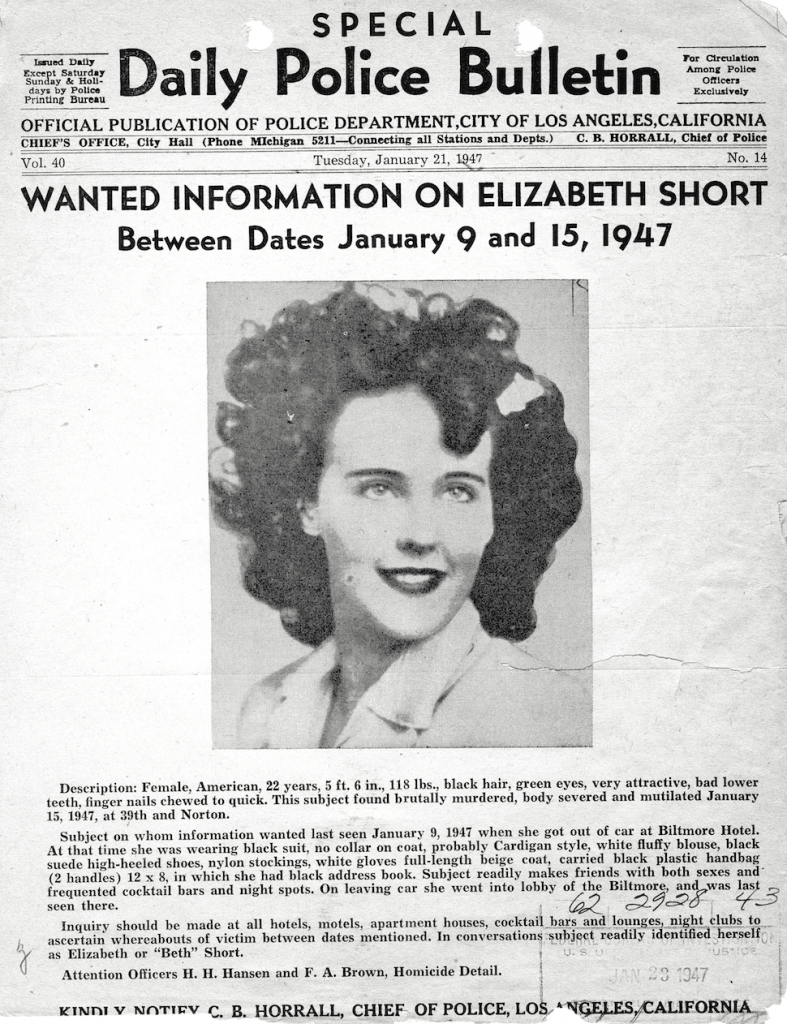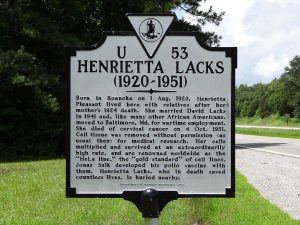Winner of the Fall 2019 StMU History Media Award for
Best Article in the Category of “Crime”
Elizabeth Short, widely known as The Black Dahlia, was a young 22-year-old American woman who was raped, brutally murdered, dismembered, and thrown on a vacant lot in a Los Angeles suburb for everyone to see. Elizabeth’s murder took place in Los Angeles County on January 15, 1947. No one knows the exact events that led to Elizabeth Short’s last moments when she fought for her life. There was no murder confession, and there was a lack of evidence to lead investigators further. Sadly, Elizabeth Short and her family never saw justice for her brutal murder. To this day, the case of The Black Dahlia is still unsolved. A man named Steve Hodel believed that The Black Dahlia murder was in fact not unsolved. Steve Hodel, a former detective, believed he had solved one of Los Angeles’ most notorious murders—but the infamous, troubled, charismatic doctor that Steve Hodel accused for being Short’s murderer, happened to be his own father, George Hodel.1
Elizabeth Short aspired to be an actress, and her young life was full of drinking and partying. She was very attracted to men and the sexual connections that came with men. Short had a desire to attend nightspots and nightclubs. Going to these nightspots, she frequently drew attention to herself, and she was arrested on September 23, 1943 for underage drinking of alcohol. She was only nineteen.2 By this time, Elizabeth had achieved a reputation as an aspiring actress who would go to bed with anyone who could possibly offer her a part in a movie.3 But her lifestyle soon led her to have a horrible encounter with a horrible man.

January 15, 1947 was just like any other day in the Los Angeles area. It was especially cool and overcast, which set the mood for the horrific discovery later that morning. A woman walking with her young daughter caught a glimpse of white flesh through a clump of brown grass in a vacant lot just a few inches from the sidewalk.4 They stumbled across the horrific sight of Elizabeth Short’s naked body cut in half just above the hipbone, drained of blood and arranged as if on display, with her legs spread and arms raised at right angles above her head. In a gruesome addition, two knife gashes extended her mouth up towards her ears.5 Her body also had the letters “B D” carved deeply into one thigh, and these letters were believed to represent the initials of Elizabeth Short’s well-known nickname Black Dahlia.6 This name stuck with her because of her tendency to always wear black clothing that contrasted with her white complexion, as well as having a dahlia flower in her hair on most occasions.7

George Hodel seemed to be an extraordinary man. He was a phenomenal doctor with a very respected reputation. Due to the extensive dismembering and perfect cuts discovered on Elizabeth’s body, her murderer had to have been a doctor.8 A couple years after the Black Dahlia murder, in 1949, Dr. Hodel’s reputation was left in tatters when he was tried for incest with his daughter Tamar Hodel, Steve Hodel’s half-sister.9 This trial brought light to George Hodel’s name in the police department. Because everyone knew that he was a very talented doctor, Dr. Hodel was put at the top of the suspect list for Elizabeth Short’s murder. Due to police corruption at the time, Dr. Hodel’s possible guilt was not presented to the public.
Dr. Hodel ended up passing away on May 16, 1999 due to a heart attack.10 Upon his passing, his son Steve Hodel began an intensive investigation into his father’s past. Steve Hodel made the trip to his father’s home to gather his father’s assets. While looking through his father’s belongings, Steve came across a tiny, palm-sized wood-bound photo album, with twelve golden fleurs-de-lys imprinted on the front.11 Inside this photo album, Steve discovered a number of strange photos of many familiar women. One of the women looked very similar to the Black Dahlia, Elizabeth Short. There were two photos of this women. In one, the woman had paper dahlia flowers in her hair. In the other, the woman was nude with her eyes shut.12 After Steve realized that the women in his father’s old photo album was the Black Dahlia, he became determined to find answers, to possibly clear his father’s name in the eyes of the law. Shortly into his private investigation, Steve Hodel realized that the evidence he was uncovering led to his father’s obvious guilt, not his exoneration. Now he wanted only to do all he could to prove it.
When Steve Hodel started the investigation into his father’s connection to the murder of the Black Dahlia, he found a substantial amount of sufficient yet circumstantial evidence against him. He soon found out that his father and Elizabeth Short knew each other. They had met in 1944 and had begun a non-sexual relationship. George would provide Elizabeth with financial aid for food and rent whenever she needed it in return for showing love interest in George. Steve’s suspicions of his father’s guilt skyrocketed when he came to find out that Elizabeth and his father were together at a downtown hotel three days before Elizabeth’s body was found. During the course of Steve Hodel’s investigation, he recognized his father’s unique handwriting multiple times, especially on the original note mailed by the Black Dahlia Avenger to the LAPD and to the press. The note with his father’s handwriting read “Here it is; Turning in Wed; Jan. 29 10 A.M.; Had my fun at police; Black Dahlia Avenger.” This was the first note that the Black Dahlia Avenger made no attempt to distort or conceal his actual handwriting.13 Hand writing analysis has since confirmed these claims. Although this evidence is circumstantial, Steve Hodel was very passionate in proving his father’s guilt. Another piece of incriminating evidence was a white-faced military watch that Dr. Hodel was seen wearing in contemporary photographs. A similar watch was found in the vacant lot close to where Elizabeth’s body was found.14
A number of men and one woman confessed to the crime, but none of them were able to match the gory details of the slaying known only by the police.15 Elizabeth’s murder seemed to bring out the worst among the psychologically disturbed in the Los Angeles area. The police were overwhelmed with the number of people who confessed to the murder.16 Despite all of these possible killers, Steve Hodel still truly believes that George Hodel was the guilty one.

The former detective for the LAPD and George Hodel’s son, Steve Hodel, had concluded his investigation on his father’s guilt, and developed an accurate timeline and detailed insight into Elizabeth Short’s last moments. Steve Hodel believes that the torture began on January 14, 1947 around 3:00-4:00 PM. Around this time, George Hodel took Elizabeth Short to the Franklin House. He gagged her mouth, bound her hands and feet with rope, and then began a prolonged and systematic process in which Elizabeth was beaten and subjected to ritualistic and sadistic torture.17 The torture included, but was not limited to the infliction of minor cuts to her body. She was beaten and kicked about her entire body, and she was forced to eat her own or his fecal excrement. Large pieces of flesh were cut from Elizabeth’s body and inserted into her orifices. Her face and breasts were also cut to imitate two of Man Ray’s famous photographs.18 Following this unimaginable torture, George Hodel then proceeded to sexually assault the then-slain Elizabeth Short.19 Although Elizabeth Short’s murderer was never convicted, it is now widely believed that George Hodel is the guilty one. The case of the Black Dahlia is considered an unsolved murder to this day, which makes it the most horrific unsolved murder in American history.20 Steve Hodel did not start his investigation until after George Hodel passed away, and only then because he passed away. George Hodel got away with his crime for over forty years. And even if he had not passed away until later in his life, face it, he still probably wouldn’t have ever been held to pay for his crime.
- Grace Bradberry, “My father was the Black Dahlia killer,” The Times, April 24, 2003. ↵
- Steve Hodel, Black Dahlia Avenger: A Genius for Murder (New York: Arcade Pub., 2003), 18. ↵
- Spectacular Crimes of the 1940s, 2007, s.v. “The Black Dahlia Case.” ↵
- Steve Hodel, Black Dahlia Avenger: A Genius for Murder (New York: Arcade Pub., 2003), 10. ↵
- Grace Bradberry, “My father was the Black Dahlia killer,” The Times, April 24, 2003. ↵
- Women in World History: A Biographical Encyclopedia, 2002, s.v. “Short,Elizabeth(1925–1947),” by Anne Commire. ↵
- Women in World History: A Biographical Encyclopedia, 2002, s.v. “Short,Elizabeth(1925–1947),” by Anne Commire. ↵
- Grace Bradberry, “My father was the Black Dahlia killer,” The Times, April 24, 2003. ↵
- Grace Bradberry, “My father was the Black Dahlia killer,” The Times, April 24, 2003. ↵
- Steve Hodel, Black Dahlia Avenger: A Genius for Murder (New York: Arcade Pub., 2003), 22. ↵
- Steve Hodel, Black Dahlia Avenger: A Genius for Murder (New York: Arcade Pub., 2003), 36. ↵
- Grace Bradberry, “My father was the Black Dahlia killer,” The Times, April 24, 2003. ↵
- Steve Hodel, Black Dahlia Avenger: A Genius for Murder (New York: Arcade Pub., 2003), 273. ↵
- Steve Hodel, Black Dahlia Avenger: A Genius for Murder (New York: Arcade Pub., 2003), 445. ↵
- Women in World History: A Biographical Encyclopedia, 2002, s.v. “Short, Elizabeth (1925–1947),” by Anne Commire. ↵
- Spectacular Crimes of the 1940s, 2007, s.v. “The Black Dahlia Case.” ↵
- Steve Hodel, Black Dahlia Avenger: A Genius for Murder (New York: Arcade Pub., 2003), 434. ↵
- Steve Hodel, Black Dahlia Avenger: A Genius for Murder (New York: Arcade Pub., 2003), 445. ↵
- Steve Hodel, Black Dahlia Avenger: A Genius for Murder (New York: Arcade Pub., 2003), 434. ↵
- Women in World History: A Biographical Encyclopedia, 2002, s.v. “Short, Elizabeth(1925–1947),” by Anne Commire. ↵



115 comments
Briana Montes
Overall, great article and very well written. Elizabeth still had so many more years to live and that was taken from her. I find that so saddening what George did to her. I don’t understand it is so easy for someone to get away with serious crimes like this. I believe Elizabeth deserved justice and peace. I didn’t like that the police had evidence and didn’t do anything about it.
Jose Chaman
It is implausible that this variety of injustice occurs in the world. What Hodel did is something dreadful and petrifying, how somebody can kill someone so full of life and with so much yet to be done? This story shows that reality often surpasses fiction. This article has structured the order of events very well and has a decent and fluid tone.
Amanda Uribe
Elizabeth Short had so much of her life left to live when she was murdered. It is actually horrendous what George Hodel did to her. I don’t understand how someone can get away with something so horrible. I liked the storytelling in this article, although it was so sad. Elizabeth deserved justice.
Michael Lazcano
It’s odd that before this article I had never heard of “Black Delilah”, or the murder story that unfolded. I think the fact that the police had substantial evidence against the man yet did not convict him possibly due to corruption within the police force is tragic. Not only does this show that the humanity of man is easily flawed when bribed, but this story also shows the compassion of man. To be quite honest it would be very difficult figuring out your own father had committed a murder, I don’t know how I would react. To see that despite his personal connection he was willing to give up his father is a saving grace in a gruesome story.
Victoria Muller
This story sure was crazy I can’t believe that it was never solved. I hadn’t heard of the “Black Dahlia” until now and I must say it is very different from the murders that I have heard of. Steve Hodel is very courageous, in finding the pictures and trying to prove his father was innocent he found that it was the opposite and he didn’t try to cover it up Instead he chose to do the right thing and do his best to uncover the truth even though it was against his own father.
Leopoldo Martinez-Milland
The story told here by Saira Locke of the murder of The Black Dhalia reminded me too much of an American Horror Story flashback (turned out her death was indeed a flashback in the 1st season) in how realistically gruesome she depicted the death of the young actress. Nevertheless, it was still a great read that led me to look more into The Black Dhalia case myself. Another thing I found interesting was Steve Holden’s reaction to all the evidence he discovered pointing his father of violently murdering Short. I would also be disgusted if I found out that the person I grew up idolizing would do such a vile thing. Again, Locke did a great job with the article and putting the reader in the horror-filled nightmare that makes everyone hate the despicable Dr. George Hodel, and rightfully so.
Isabella Torres
It is so disgusting what people like George Hodel were capable of doing. I have never heard of this case before, but the crimes committed were very disturbing and they make me wonder why this case isn’t more well known. It must have been a horrible experience for Steve Hodel to come to the realization that his own father was the one who committed these horrible acts. It is even worse that Elizabeth Short’s family never received the justice they deserved and that George was never faced with any consequences.
Azucena Cuevas
The article is really detailed and informative. I really enjoyed reading it because it keeps the reader engaged with the vivid imagery displayed. Also, I have never heard about Black Dahlia case. I think it insane how the killer got away with it for forty years before he eventually passed on. The corruption in the police force caused this murder to wash away and it’s quite tragic the minimal attention they gave to it.
Priscilla Poorbaugh
I knew about this murder because of how famous it is, but I did not know all of the details about it. I feel like the evidence found by the detective and Hodel’s son proves that George Hodel was the one responsible for the Black Dahlia’s death. It is so sad that they never got justice for her brutal death, and they honestly may never.
Raul Vallejo
After reading this article I could not believe that this was a crime that had happened in real life and not from a movie. It is so unfortunate that Elizabeth Short lost her life, but it is almost just as bad that the man who committed the crime, Dr. Hodel, never had to suffer any consequences for his actions. I feel for the family of the victim knowing that the murderer that this such terrible things to their relative was still roaming the streets, and to the son of the doctor who had to prove how much of a monster his father really was.